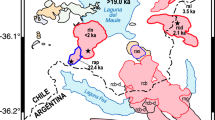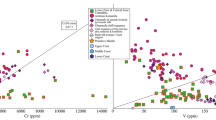Abstract
The small leucogranite plutons occurring in linear belts in the Higher Himalayas have formed due to post-collision partial melting within the Himalayan crust. Several studies have documented that the Sr isotopic ratios in the granite bodies show chaotic variation and meaningful Rb-Sr isochron ages are difficult, if not impossible, to obtain. In tectonically overthickened crust, the depth-temperature profile (geotherm) remains strongly transient for the first tens of millions of years. It is proposed here that the intersecting relations between the transient geotherms and activity-dependent solidus/melting curves may generate small pods of magma at different depths and at different times. Each of these pods will have its unique Sr isotopic ratios. Coalescence of these small pods of magma without any effective homogenization due to deformation-induced fast segregation, ascent and emplacement may lead to pluton-wide extreme heterogeneity in Sr isotopic ratios.
Similar content being viewed by others
References
Bird P 1978 Initiation of intracontinental subduction in the Himalaya;J. Geophys. Res. 83 4975–4987
Brown M 1994 The generation, segregation and emplacement of granite magma: the migmatite-to-crustally-derived granite connection in thickned orogens;Earth Sci. Rev. 36 83–130
Carslaw H S and Jeager J C 1959Conduction of Heat in Solids; Oxford University Press, 510p.
Chander R and Gahalaut V K 1995 A simulation of upper crustal stresses for great and moderate thrust earthquakes of the Himalaya;Proc. Indian Acad. Sci. (Earth Planet. Sci.) 104 115–129
Clemens J D and Mawer C K 1992 Granitic magma transport by fracture propagation;Tectonophysics 204 339–360
Deniel C, Vidal P, Fernandez A, Le Fort P, and Peucat J-J 1987 Isotopic study of the Manaslu granite (Himalaya, Nepal): Inferences on the age and source of Himalayan Leucogranites;Contrib. Mineral. Petrol. 96 78–92
Dietrich V and Gansser A 1981 The leucogranites of the Bhutan Himalaya (crustal anatexis versus mantle melting);Schweiz. Mineral. Petrogr. Mitt. 61 177–202
Ebadi A and Johannes W 1991 Beginning of melting and composition of first melts in the system Qz-Ab-Or-H2O-CO 2;Contrib. Mineral. Petrol. 106 286–295
England P C and Molnar P 1993 The interpretation of inverted metamorphic isograds using simple physical calculations;Tectonics 12 145–157
England P C and Thompson A B 1984 Pressure-temperature-time paths of regional metamorphism of the continental crust, I, Heat transfer during the evolution of regions of thickened continental crust;J. Petrol. 25 894–928
England P, Le Fort P, Molnar P and Pecher A 1992 Heat sources for tertiary metamorphism and anatexis in the Annapurna-Manaslu region, central Nepal;J. Geophys. Res. 97 2107–2128
Francheteau J, Jaupart C, Jie S X, Wen-Hua K, De-Lu L, Jia-Chi B, Hung-Pin W and Hsia-Yeu D 1984 High heat flow in southern Tibet;Nature 307 32–36
Faure G 1986Principles of Isotope Geology; (John Wiley & Sons)
Hirn A, Lepine J-C, Jobert G, Sapin M, Wittlinger G, Xin X Z, Yuan G E, Jing W X, Wen T J, Bai X S, Pandey M R and Tater J M 1984 Crustal structure and variability of the Himalayan border of Tibet;Nature 307 23–25
Holdaway M J and Mukhopadhyay B 1993 A reevaluation of the stability relations of andalusite: Thermochemical data and phase diagram for aluminium silicates.Amer. Min. 78 298–315
Hubbard M and Harrison T M 198940Ar/39Ar age constraints in deformation and metamorphism in the Main Central Thrust Zone and Tibetan Slab, Eastern Nepal Himalaya;Tectonics 8 865–880
Jaupart C and Provost A 1985 Heat focussing, granite genesis and inverted metamorphic gradients in continental collision zones;Earth Planet. Sci. Lett. 73 385–397
Klootwijk C T, Gee J S, Peirce J W, Smith G M and McFadden P L 1992 An early India-Asia contact: paleomagnetic constraints from Ninetyeast Ridge, ODP Leg 121;Geology 20 395–398
Lachenbruch A H and Saas J H 1977 Heat flow in the United States and the thermal regime of the crust; InThe Earth's Crust (ed.) J G Heacock (AGU, Washington:Geophys. Mon. Sr. 20) pp. 626–675
Le Fort P 1981 Manaslu leucogranite: a collision signature of the Himalaya. A model for its genesis and emplacement;J. Geophys. Res. 86 10545–10568
Le Fort P, Cuney M, Deniel C, France-Lanord C, Sheppard S M F, Upreti B N and Vidal P 1987 Crustal generation of Himalayan leucogranites;Tectonophysics 134 39–57
Molnar P 1987 Inversion of profiles of uplift rates for the geometry of dip-slip faults at depth, with examples from Alps and Himalaya;Annales Geophysicae 5B(6) 663–670
Molnar P, Chen W-P and Padovani E 1983 Calculated temperatures in overthrust terranes and possible combination of heat sources responsible for the Tertiary granites in the greater Himalaya;J. Geophys. Res. 88 6415–6429
Molnar P and England P 1990 Temperatures, heat flux, and frictional stress near major thrust faults;J. Geophys. Res. 95 4833–4856
Ni J and Barazangi M 1984 Seismotectonics of the Himalayan collision zone: geometry of the underthrusting beneath the Himalaya;J. Geophys. Res. 89 1147–1163
Oxburgh E R and Turcotte D 1974 Thermal gradients and regional metamorphism in overthrust terrains with special reference to eastern Alps;Schweiz. Mineral. Petrogr. Mitt. 54 641–662
Pinet C and Jaupart C 1987 A thermal model for the distribution in space and time of the Himalayan granites;Earth Planet. Sci. Lett. 84 87–99
Scaillet B, Pecher A, Rochette P and Champenois M 1995 The Gangotri granite (Garhwal Himalaya): laccolithic emplacement in an extending collisional belt;J. Geophys. Res. 100 585–607
Scaillet B, Holtz F, Pichavant and Schmidt M 1996 Viscosity of Himalayan leucogranites: Implications for mechanisms of granitic magma ascent;J. Geophys. Res. 101 27691–27699
Sclatter J G, Jaupart C and Galson D 1980 The heat flow through oceanic and continental crust and heat loss of the earth;Rev. Geophys. Space Phys. 18 269–311
Seeber L, Ambruster J G and Quittmeyer R C 1981 Seismicity and continental subduction in the Himalayan arc; InZagros, Hindu-Kush, Himalaya Geodynamic Evolution (eds.) H K Gupta and F M Delany (AGU, Washington: Geodynamic Sr. 3) pp. 215–242
Shanker R 1989 Heat flow regime in Himalaya;Geol. Surv. India Sp. Pubn. 26 181–192
Shi Y and Wang C-Y 1987 Two-dimensional modeling of the P-T-t paths of regional metamorphism in simple overthrust terrains;Geology 15 1048–1051
Spear F S 1993 Metamorphic phase equilibria and pressure-temperature-time paths;Min. Soc. Amer. Monograph 799p
Stern C R, Kligfield R, Schelling D, Virdi N S, Futa K and Peterman Z E 1989 The Bhagirathi leucogranite of High Himalaya (Garhwal, India): age, petrogenesis, and tectonic implications;Geol. Soc. Am. Sp. Paper 232 33–45
Thompson A B 1981 The pressure-temperature (P,T) plane viewed by geophysicists and petrologists;Terra Cognita 1 11–20
Zeitler P K and Chamberlain C P 1991 Petrogenetic and tectonic significance of young leucogranites from the northwestern Himalaya, Pakistan;Tectonics 10 729–741
Author information
Authors and Affiliations
Rights and permissions
About this article
Cite this article
Mukhopadhyay, D.K. Extreme heterogeneity in sr isotope systematic in the himalayan leucogranites: A possible mechanism of partial melting based on thermal modeling. J Earth Syst Sci 110, 161–169 (2001). https://doi.org/10.1007/BF02702215
Received:
Revised:
Issue Date:
DOI: https://doi.org/10.1007/BF02702215




